JVC SP-THL1C, SP-THL1S, SP-THL1F, AX-THL1, SP-THL1W User Manual
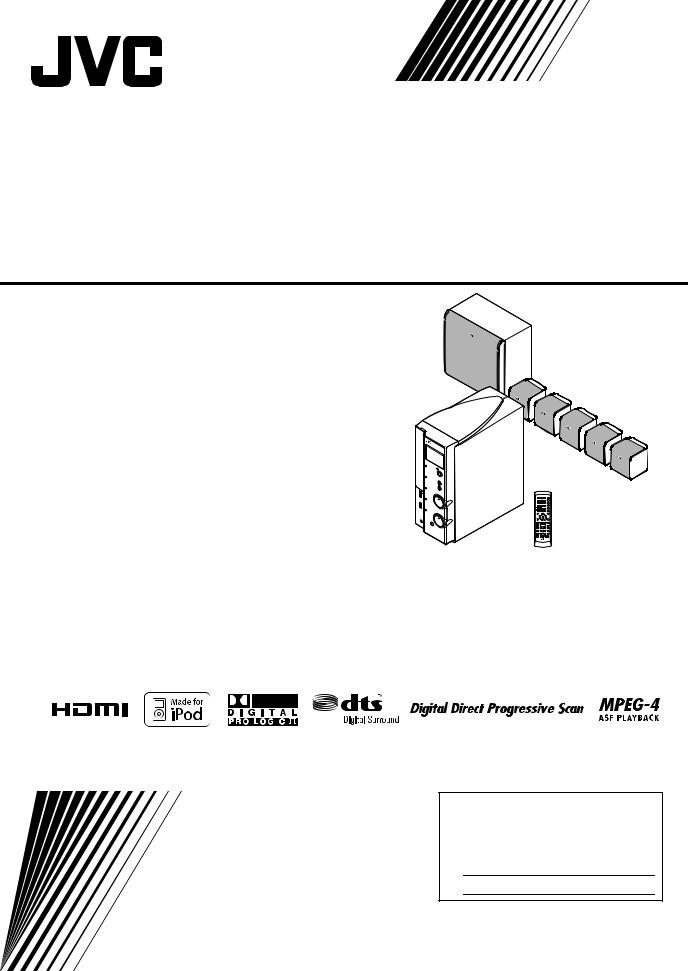
DIGITAL MEDIA SYSTEM
TH-L1
Consists of AX-THL1, SP-THL1W,
SP-THL1F, SP-THL1C and SP-THL1S
INSTRUCTIONS
For Customer Use:
Enter below the Model No. and Serial No. which are located either on the rear, bottom or side of the cabinet. Retain this information for future reference.
Model No.
Serial No.
GVT0206-001A [J, C]
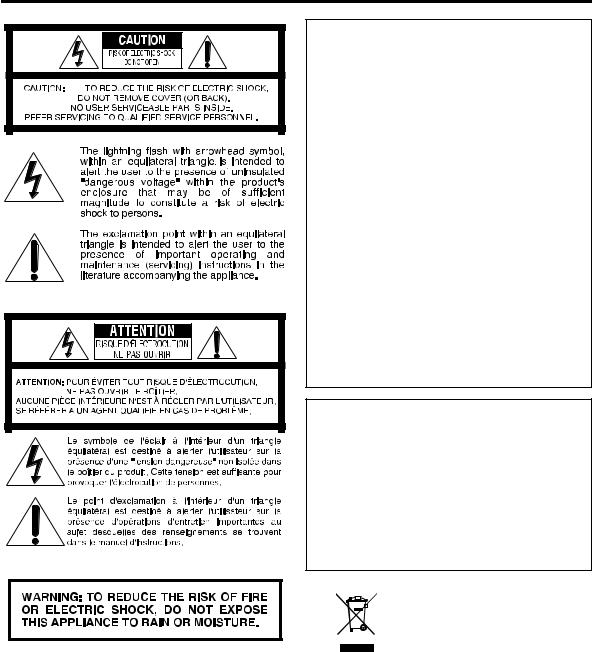
Warnings, Cautions and Others
Mises en garde, précautions et indications diverses
CAUTION— 
 button!
button!
Disconnect the mains plug to shut the power off completely (the STANDBY lamp goes off). When installing the apparatus, ensure that the plug is easily accessible.
The 
 button in any position does not disconnect the mains line.
button in any position does not disconnect the mains line.
• When the system is on standby, the STANDBY lamp lights red.
• When the system is turned on, the STANDBY lamp goes off.
The power can be remote controlled.
ATTENTION—Touche 

Déconnectez la fiche secteur pour mettre l’appareil complètement hors tension (le témoin STANDBY s'éteint). Lors de l’installation de l’appareil, assurez-
vous que la fiche soit facilement accessible.
La touche 
 , dans n’importe quelle position, ne déconnecte pas le système du secteur.
, dans n’importe quelle position, ne déconnecte pas le système du secteur.
• Quand le système est en attente, le témoin STANDBY est allumé en rouge.
• Quand le système est sous tension, le témoin STANDBY s'éteint.
L'alimentation peut être télécommandée.
CAUTION
To reduce the risk of electrical shocks, fire, etc.: 1. Do not remove screws, covers or cabinet.
2. Do not expose this appliance to rain or moisture.
ATTENTION
Afin d’éviter tout risque d’électrocution, d’incendie, etc.:
1. Ne pas enlever les vis ni les panneaux et ne pas ouvrir le coffret de l’appareil.
2. Ne pas exposer l’appareil à la pluie ni à l’humidité.
[European Union only]
[Union européenne seulement]
G-1

Warnings, Cautions and Others/Mises en garde, précautions et indications diverses
For U.S.A.
This equipment has been tested and found to comply with the limits for a Class B digital device, pursuant to part 15 of the FCC Rules. These limits are designed to provide reasonable protection against harmful interference in a residential installation.
This equipment generates, uses and can radiate radio frequency energy and, if not installed and used in accordance with the instructions, may cause harmful interference to radio communications. However, there is no guarantee that interference will not occur in a particular installation. If this equipment does cause harmful interference to radio or television reception, which can be determined by turning the equipment off and on, the user is encouraged to try to correct the interference by one or more of the following measures: Reorient or relocate the receiving antenna.
–Increase the separation between the equipment and receiver.
–Connect the equipment into an outlet on a circuit different from that to which the receiver is connected.
–Consult the dealer or an experienced radio/TV technician for help.
CAUTION
Changes or modifications not approved by JVC could void the user’s authority to operate the equipment.
CAUTION
Excessive sound pressure from earphones or headphones can cause hearing loss.
ATTENTION
Une pression acoustique excessive des écouteurs ou du casque d’écoute peut entraîner une perte auditive.
For Canada/pour le Canada
THIS DIGITAL APPARATUS DOES NOT EXCEED THE CLASS B LIMITS FOR RADIO NOISE EMISSIONS FROM DIGITAL APPARATUS AS SET OUT IN THE INTERFERENCE-CAUSING EQUIPMENT STANDARD ENTITLED “DIGITAL APPARATUS,” ICES-003 OF THE DEPARTMENT OF COMMUNICATIONS.
CET APPAREIL NUMERIQUE RESPECTE LES LIMITES DE BRUITS RADIOELECTRIQUES APPLICABLES AUX APPAREILS NUMIRIQUES DE CLASSE B PRESCRITES DANS LA NORME SUR LE MATERIEL BROUILLEUR; “APPAREILS NUMERIQUES”, NMB-003 EDICTEE PAR LE MINISTRE DES COMMUNICATIONS.
CAUTION
•Do not block the ventilation openings or holes.
(If the ventilation openings or holes are blocked by a newspaper or cloth, etc., the heat may not be able to get out.)
•Do not place any naked flame sources, such as lighted candles, on the apparatus.
•When discarding batteries, environmental problems must be considered and local rules or laws governing the disposal of these batteries must be followed strictly.
•Do not expose this apparatus to rain, moisture, dripping or splashing and that no objects filled with liquids, such as vases, shall be placed on the apparatus.
ATTENTION
•Ne bloquez pas les orifices ou les trous de ventilation. (Si les orifices ou les trous de ventilation sont bloqués par un journal un tissu, etc., la chaleur peut ne pas être évacuée correctement de l’appareil.)
•Ne placez aucune source de flamme nue, telle qu’une bougie, sur l’appareil.
•Lors de la mise au rebut des piles, veuillez prendre en considération les problèmes de l’environnement et suivre strictement les règles et les lois locales sur la mise au rebut des piles.
•N’exposez pas cet appareil à la pluie, à l’humidité, à un égouttement ou à des éclaboussures et ne placez pas des objets remplis de liquide, tels qu’un vase, sur l’appareil.
G-2
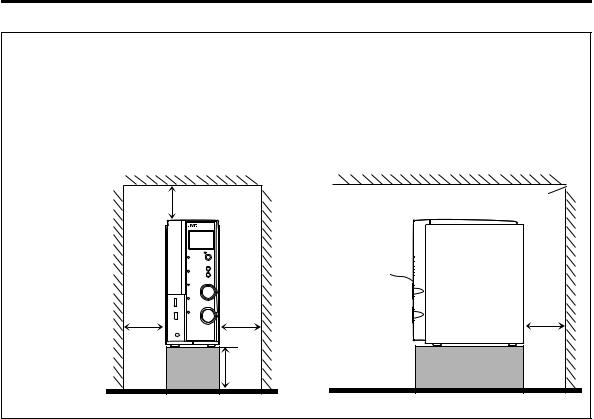
Warnings, Cautions and Others/Mises en garde, précautions et indications diverses
Caution: Proper Ventilation
To avoid risk of electric shock and fire and to protect from damage, place the apparatus on a level surface. The minimal clearances are shown below:
Attention: Ventilation Correcte
Pour éviter les chocs électriques, les incendies et tout autre dégât, poser l’appareil sur une surface plate. Le dégagement minimum est indiqué ci-dessous:
Front view/Face |
Side view/Côté |
Wall or obstructions Mur, ou obstruction
15 cm |
|
Wall or obstructions/Mur, ou obstruction |
||
|
|
|
||
(5-15/16") |
AX-THL1 |
|
AX-THL1 |
|
|
|
Front |
|
|
|
|
Avant |
|
|
15 cm |
15 cm |
No obstructions |
15 cm |
|
(5-15/16") |
(5-15/16") |
(5-15/16") |
||
Aucune |
||||
|
|
|
||
|
|
obstruction |
|
|
|
15 cm |
|
|
|
|
(5-15/16") |
|
|
|
G-3

Table of contents
Introduction ........................................... |
2 |
Notes on handling ......................................................... |
2 |
Supplied accessories ...................................................... |
2 |
About files .............................................. |
3 |
Playable file types for the USB MEMORY ................ |
3 |
Index of parts and controls ................... |
4 |
Front panel (center unit) .............................................. |
4 |
Rear panel (center unit) ............................................... |
5 |
Remote control .............................................................. |
6 |
Connections ............................................ |
7 |
Connecting the speakers and subwoofer ................... |
7 |
Speaker layout ................................................................ |
8 |
Connecting a TV ........................................................... |
9 |
Connecting the video components for the source of |
|
VIDEO 1........................................................................ |
10 |
Connecting the video components for the source of |
|
VIDEO 2........................................................................ |
11 |
Connecting the video components for the source of |
|
VIDEO 3........................................................................ |
12 |
Connecting a USB mass storage class device .......... |
13 |
Connecting the iPod .................................................... |
13 |
Connecting the power cord ....................................... |
13 |
Operating the TV and DVD player ...... |
14 |
Operating the TV ........................................................ |
14 |
Operating the DVD player ........................................ |
15 |
Basic operations .................................. |
16 |
Turning the system on/off .......................................... |
16 |
Selecting the source to play ........................................ |
16 |
Adjusting the volume [VOLUME] ............................ |
17 |
Listening with headphones (not supplied) ............... |
17 |
Turning off the sound temporarily [MUTING] ...... |
17 |
Adjusting the brightness of the indications |
|
[DIMMER] ................................................................... |
17 |
Sleep Timer [SLEEP] ................................................... |
17 |
Adjusting the output level of the speakers and |
|
subwoofer ...................................................................... |
18 |
Changing the scanning mode ..................................... |
18 |
Operations for iPod ............................. |
19 |
Playing an iPod ............................................................. |
19 |
Operations for USB MEMORY ............. |
21 |
Basic operations for USB MEMORY ........................ |
21 |
Advanced operations for USB MEMORY ................ |
24 |
Operations for surround mode ........... |
27 |
Using the surround mode ........................................... |
27 |
Setting preferences ............................. |
29 |
Using the setup menus ................................................ |
29 |
Menu description ......................................................... |
29 |
Setting the audio terminal .......................................... |
31 |
References ............................................ |
32 |
Troubleshooting ........................................................... |
32 |
Specifications ................................................................ |
33 |
I |
|
1

Introduction
Notes on handling
7 Important cautions
Installation of the system
•Select a place which is level, dry and neither too hot nor too cold; between 5°C and 35°C (41°F and 95°F).
•Leave sufficient distance between the system and the TV.
•Do not use the system in a place subject to vibration.
Power cord
•Do not handle the power cord with wet hands.
•A small amount of power is always consumed while the power cord is connected to the wall outlet.
•Do not pull on the power cord to unplug the cord. When unplugging the cord, always grasp and pull the plug so as not to damage the cord.
To prevent malfunctions of the system
•There are no user-serviceable parts inside. If anything goes wrong, unplug the power cord and consult your dealer.
•Do not insert any metallic object into the system.
Note about copyright laws
Check the copyright laws in your country before recording from original sources. Recording of copyrighted material may infringe copyright laws.
7 Safety precautions
Avoid moisture, water and dust
Do not place the system in moist or dusty places.
Avoid high temperatures
Do not expose the system to direct sunlight and do not place it near a heating device.
When you are away
When away on travel or for other reasons for an extended period of time, disconnect the power cord plug from the wall outlet.
Do not block the vents
Blocking the vents may damage the system.
Care of the cabinet
•Stains on the system should be wiped off with a soft cloth.
If the system is heavily stained, wipe it with a cloth soaked in water diluted neutral detergent and wrung well, then wipe clean with a dry cloth.
•Since the system may deteriorate in quality, become damaged or get its paint peeled off, be careful about the following.
–DO NOT wipe it forcefully.
–DO NOT wipe it with thinner, benzine or other organic solvents including disinfectants.
–DO NOT apply any volatile substance such as insecticides to it.
–DO NOT allow any rubber or plastic to remain in contact with it for a long time.
If water gets inside the system
Turn the system off and disconnect the power cord plug from the wall outlet, then call the store where you made your purchase. Using the system in this condition may cause a fire or electrical shock.
Supplied accessories
Check to be sure you have all of the supplied accessories. The number in parentheses is the quantity of the pieces supplied.
If anything is missing, contact your dealer immediately.
•Remote control (1)
•Batteries (2)
•Composite Video cord (1)
•Connection cable for iPod (1)
•Stand for iPod (1)
•This product incorporates copyright protection technology that is protected by U.S. patents and other intellectual property rights. Use of this copyright protection technology must be authorized by
Macrovision, and is intended for home and other limited viewing uses only unless otherwise authorized by Macrovision. Reverse engineering or disassembly is prohibited.
•iPod is a trademark of Apple Inc., registered in the U.S. and other countries.
•USE OF THIS PRODUCT IN ANY MANNER THAT
COMPLIES WITH THE MPEG-4 VISUAL STANDARD IS PROHIBITED, EXCEPT FOR USE BY
A CONSUMER ENGAGING IN PERSONAL AND
NON-COMMERCIAL ACTIVITIES.
•Microsoft and Windows Media are either registered trademarks or trademarks of Microsoft Corporation in the United States and/or other countries.
•HDMI, the HDMI logo and High-Definition
Multimedia Interface are trademarks or registered trademarks of HDMI licensing LLC.
•HDCP is the abbreviation of “High-Bandwidth Digital
Content Protection,” and is the high-reliable copy control technology licensed by Digital Content
Protection, LLC.
2

About files
Playable file types for the USB MEMORY
For all playable files
•The system can only recognize and play files with one of the following extensions, regardless of the letter case— upper/lower:
MP3: <.MP3>, <.mp3> WMA: <.WMA>, <.wma>
WAV: <.WAV>, <.WAVE>, <.wav>, <.wave> JPEG: <.JPG>, <.JPEG>, <.jpg>, <.jpeg> MPEG-1/MPEG-2: <.MPG>, <.MPEG>, <.mpg>, <.mpeg>
ASF: <.ASF>, <.asf>
•The system recognizes up to 150 tracks (files) per group, 99 groups per device, and the total number of the tracks
(files) that the system can play is 4 000.
•Some files may not be played back normally because of their characteristics or recording conditions.
•Some files require a longer readout time. (It differs due to the complexity of the directory/file configuration.)
•If different kinds of files are mixed, set the FILE TYPE setting in the PICTURE menu to the appropriate setting for the data to be read (“AUDIO”, “STILL PICTURE” or “VIDEO”). (See page 30.)
For MP3/WMA/WAV files
•The system supports MP3/WMA files recorded at a bit rate of 32 – 320 kbps and a sampling frequency of 16 kHz, 22.05 kHz, 24 kHz (for WMA only), 32 kHz, 44.1 kHz, or
48 kHz.
•If the track information (album name, artist, and track title, etc.) is recorded, it appears in the file control display on the TV screen. (See page 24.)
•It is recommended that you make each MP3/WMA/WAV files at the following conditions:
MP3/WMA: At a sample rate of 44.1 kHz and bit rate of 128 kbps.
WAV: 44.1 kHz/16 bit Linear PCM.
For JPEG files
•It is recommended that you record a file at 640 x 480 resolution. (If a file has been recorded at a resolution of more than 640 x 480, it will take a longer time to be displayed.)
•This system can only play baseline JPEG files.
For MPEG-1/MPEG-2 files
•The stream format should conform to MPEG system/ program stream.
•720 x 576 pixels (25 fps)/720 x 480 pixels (30 fps) is recommended for the highest resolution.
•This system also supports the resolutions of 352 x 576/ 480 x 576/352 x 288 pixels (25 fps) and 352 x 480/480 x 480/352 x 240 pixels (30 fps).
•The file format should be MP@ML (Main Profile at Main Level)/SP@ML (Simple Profile at Main Level)/MP@LL (Main Profile at Low Level).
•Audio streams should conform to MPEG1 Audio Layer-2 or MPEG2 Audio Layer-2.
For ASF files
•The system supports the types of the advanced simple profile as MPEG-4 files (MPEG-4 ASF).
•The system supports MPEG-4 files with the following conditions:
File format: ASF
Visual profile: MPEG-4 SP (Simple Profile) Audio CODEC: G.726
Max. picture size: 352 x 288 (CIF) Max. bit rate: 384 kbps
3
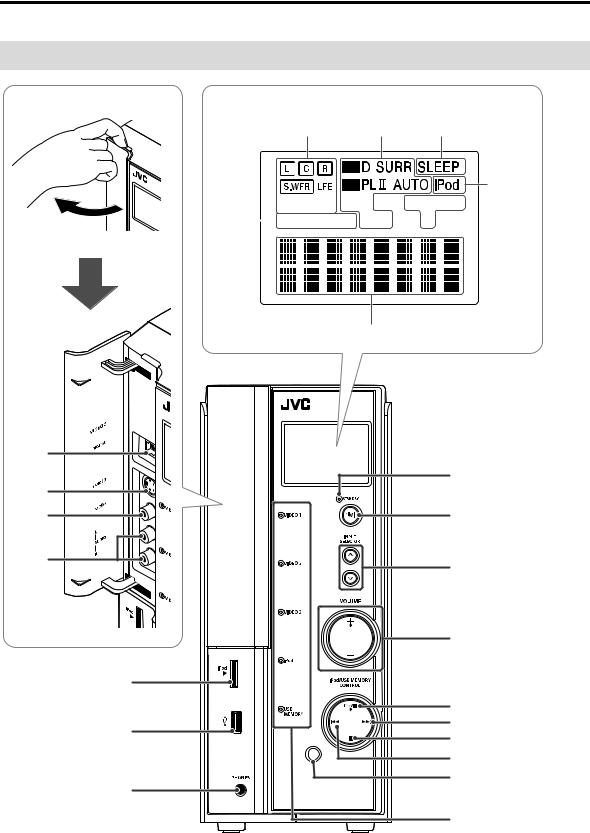
Index of parts and controls
The numbers in the figures indicate the pages where the details of the parts are described.
Front panel (center unit)
Display window
28 |
27 |
17 |
19







 26 18
26 18 







22
12 |
|
12 |
16 |
|
|
12 |
16 |
12 |
16 |
|
|
17 |
|
13 |
|
|
|
16, 20, 22, 25 |
|
13 |
20, 23 |
|
22 |
||
|
||
|
20, 23 |
|
17 |
Remote sensor: 6 |
|
|
||
|
16 |
4
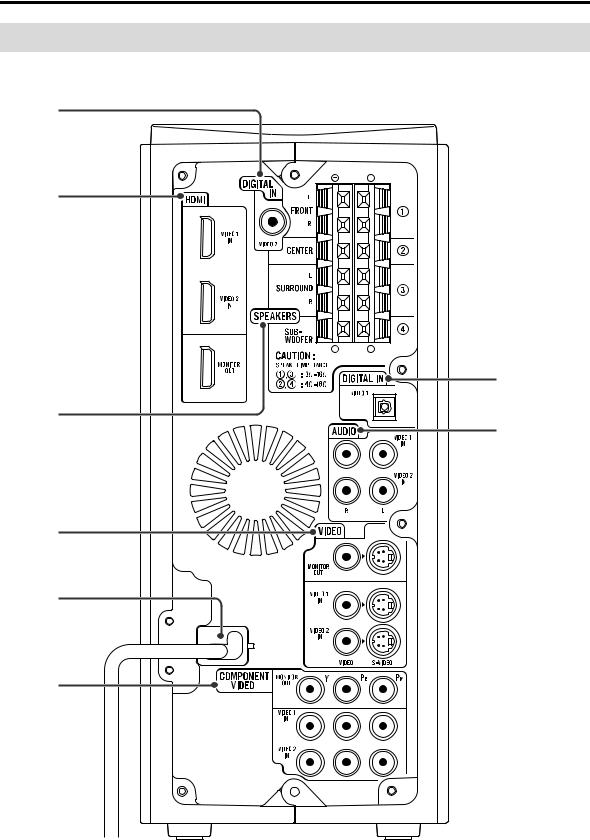
Index of parts and controls
Rear panel (center unit)
11 |
9, 10, 11 |
10 |
7 |
10, 11 |
9, 10, 11 |
13 |
9, 10, 11 |
5

Index of parts and controls
Remote control
7 Putting batteries in the remote control
|
16 |
|
Number |
14 |
|
15 |
||
buttons: |
||
14, 15, 23 |
14 |
|
14 |
||
17 |
||
15 |
||
23 |
||
16 |
||
31 |
||
15 |
||
|
||
14, 15, 18, |
15 |
|
24, 25, |
||
|
||
29 – 31 |
24 |
|
29 |
||
15, 20, |
15, 23 |
|
23, 24 |
28 |
|
16, 20 |
15, 20, 22, |
|
16, 22 – 25 |
25 |
|
15, 25 |
||
15 |
15 |
|
26 |
17 |
|
22 |
18, 25 |
|
18 |
17 |
|
14, 18 |
||
14, 15 |
14, 17 |
|
|
R6 (SUM-3)/AA (15F) type dry-cell batteries
(supplied)
If the range or effectiveness of the remote control decreases, replace both batteries.
CAUTION
•Batteries shall not be exposed to excessive heat such as sunshine, fire or the like.
Operating the system from the remote control
Aim the remote control directly to the remote sensor of the center unit.
•If you operate it from a diagonal position, the operating range (approx. 5 m (16 ft)) may be shorter.
•Do not block the remote sensor.
6
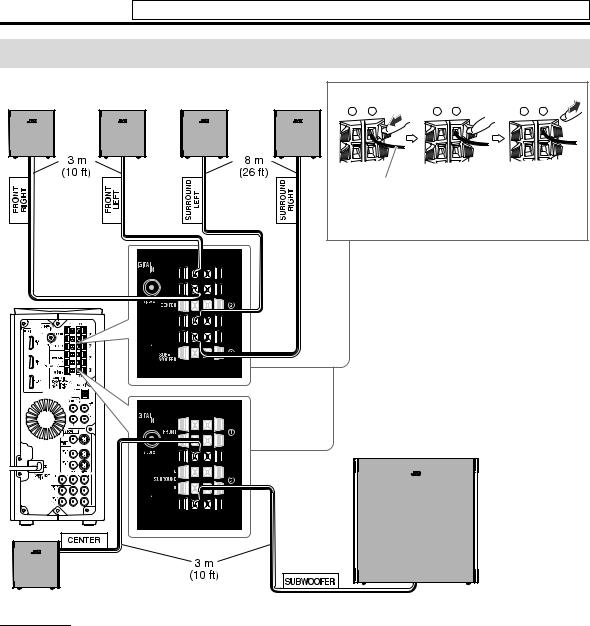
Connections
Do not connect the power cord until all other connections have been made.
Connecting the speakers and subwoofer
SP-THL1F |
|
|
|
|
|
SP-THL1S |
|
|
|
|
|
|
|
|
|
|
|
|
|
|
|
|
|
|
|
||||
Front speakers |
|
|
|
Surround speakers |
|
|
|
|
|
|
|
|
|
|
|
|
|
|
|
|
|
|
|
||||||
|
|
|
|
|
|
|
|
|
|
|
|
|
|
|
|
|
|
|
|||||||||||
|
|
|
|
|
|
|
|
|
|
|
|
|
|
|
|
|
|
|
|
|
|
|
|
|
|
|
|
|
|
|
|
|
|
|
|
|
|
|
|
|
|
|
|
|
|
|
|
|
|
|
|
|
|
|
|
|
|
|
|
|
|
|
|
|
|
|
|
|
|
|
|
|
|
|
|
|
|
|
|
|
|
|
|
|
|
|
|
|
|
Speaker cord
• Connect the black cords to the black (–) terminals.
• Connect the white cords to the red (+) terminals.
SP-THL1W
Subwoofer
SP-THL1C
Center speaker
CAUTION
•If you connect speakers other than the supplied ones, use speakers of the same speaker impedance (SPEAKER IMPEDANCE) indicated on the rear of the center unit.
•DO NOT connect more than one speaker to one speaker terminal.
•When installing the satellite speakers on the wall;
–Be sure to have them installed on the wall by qualified personnel.
DO NOT install the satellite speakers on the wall by yourself to avoid unexpected damage from falling off the wall due to incorrect installation or weakness in wall structure.
–Care must be taken in selecting a location for speaker installation on a wall. Injury to personnel or damage to equipment may result if the speakers installed interfere with daily activities.
Precautions for daily use
•When moving the speakers, do not pull the speaker cords; otherwise, the speakers may fall over, causing damage or injury.
•Do not reproduce sounds at so high a volume that the sound is distorted; otherwise, the speakers may be damaged by internal heat buildup.
7
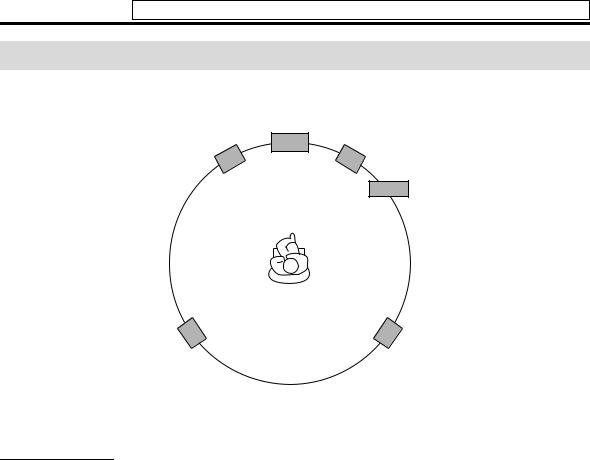
Connections
Do not connect the power cord until all other connections have been made.
Speaker layout
To obtain the best possible sound from this system, you need to place all the speakers except the subwoofer at the same distance from the listening position.
|
Center speaker |
Front left |
Front right |
speaker |
speaker |
|
Subwoofer |
Surround left |
Surround right |
speaker |
speaker |
If your speakers cannot be placed at the same distance from the listening position
You can adjust the delay time of the speakers. See “Delay menu (DELAY)” on page 30.
NOTE
•Place the satellite speakers on a flat and level surface.
•The subwoofer, front and center speakers are magnetically shielded to avoid color distortions on TVs. However, if not installed properly, they may cause color distortions. So, pay attention to the following when installing the speakers.
–When placing the speakers near a TV set, turn off the TV’s main power switch or unplug it before installing the speakers. Then wait at least 30 minutes before turning on the TV’s main power switch again.
Some TVs may still be affected even though you have followed the above. If this happens, move the speakers away from the TV.
•The surround speakers are not magnetically shielded.
If they are located nearby the TV or monitor, it will probably cause color distortion on the screen. To avoid this, do not place the speakers nearby the TV or monitor.
8
